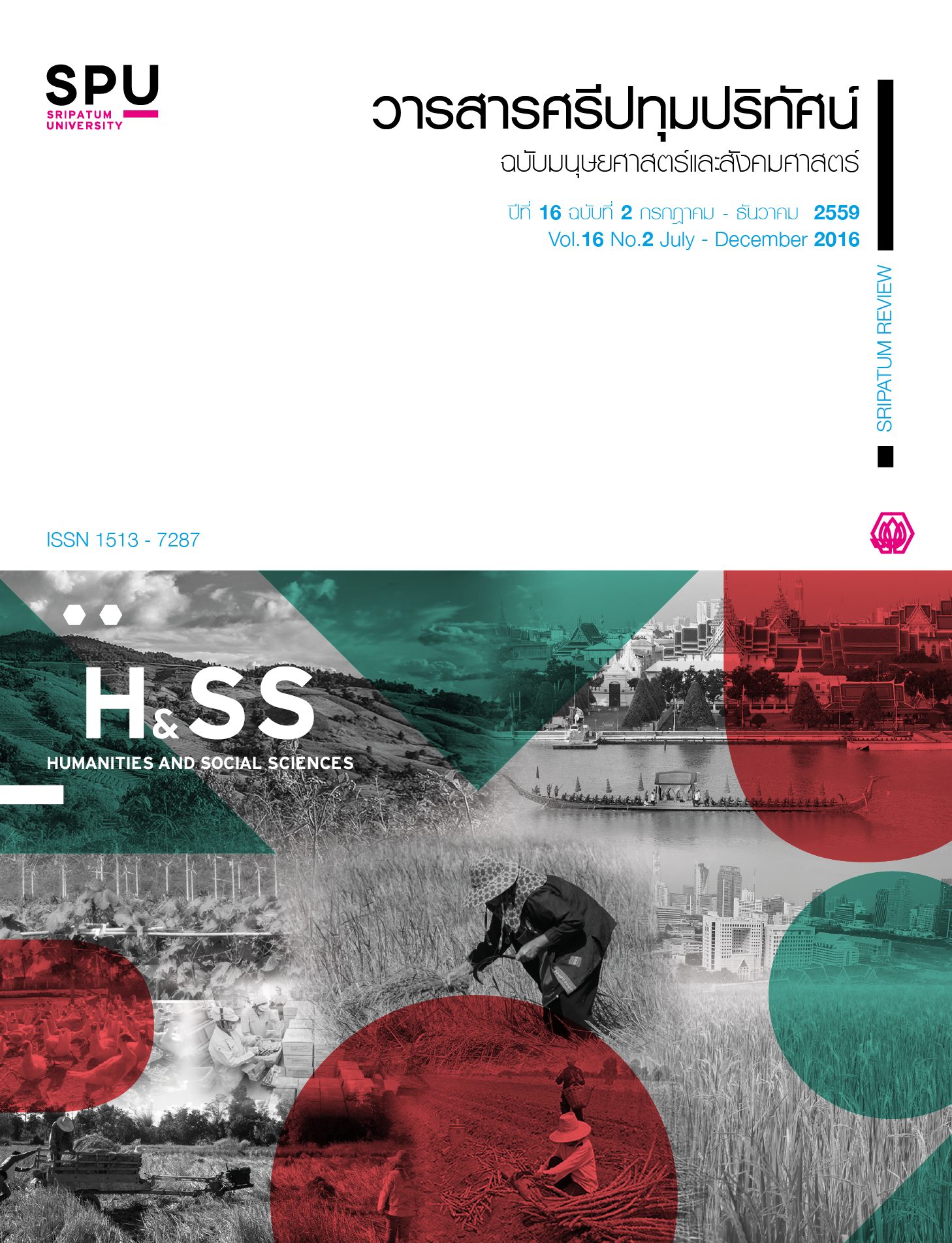THE INTEGRATION OF SOCIAL ENTERPRISE AND SUFFICIENCY ECONOMY: CASES OF SOCIAL ENTERPRISES IN THAILAND
Main Article Content
Abstract
The objectives of this research were to study the integration between the concepts of social enterprise and sufficiency economy, and to develop an integrated model of social enterprise and sufficiency economy. The researcher used qualitative research methodology to study the contexts and processes resulting in the integration between the two concepts. The sources of information used for the research were 4 case studies; all of which were social enterprises successfully integrated with the concept of sufficiency economy in Thailand. The case studies in four areas of Thailand included (1) Leung Krai Orchard, Suk Somboon Village, Wang Nam Khiew District, Nakhon Ratchasima Province; (2) Garbage Bank for Social Benefits Enterprise, Din Daeng District, Bangkok Metropolis; (3) Thai Craft Fair Trade for Social Benefits Enterprise, Sathorn District, Bangkok Metropolis, and 4) Meechai Pattana School for Social Benefits Enterprise, Lam Plaimat District, Buriram Province. The research informants were 29 people; the main informants were 4 social entrepreneurs representing the case studies, 20 informants who were closely related to the case studies, and 5 experts in the field of social enterprise and sufficiency economy. The researcher employed semi-structured in-depth interviews, observation, and cross-cases comparison for data collection. The data were qualitatively analysed with content analysis with the use of inductive reasoning to formulate conclusions on research findings.
Research findings were as follows: Firstly, the integration of social enterprise and sufficiency economy at the conceptual level requires the recognition of similarities and differences between the two concepts prior to any attempt in the integration process. Therefore, the integration should begin with adopting the concept of sufficiency economy as the starting point then undertaking the integration at the social entrepreneur level, followed by the social benefits enterprises and organizations within the network, and subsequently expand to wider networks. It could be viewed that the knowledge of sufficiency economy represents the “core” and social enterprises are the “mechanism” from the integration perspective. Secondly, the integrated model of social enterprise and sufficiency economy requires “contexts” including environmental context, social entrepreneurial context, organizational and network context, and lastly the expansion context. These contexts must be present throughout the integration process. The integration process is divided into 3 different phases starting with the pre-integration phase, followed by the integration phase, and lastly the expansion phase, each subsequent stage of integration will successively intensify the degree of integration.
Article Details
1. กองบรรณาธิการสงวนสิทธิ์ในการพิจารณาและตัดสินการตีพิมพ์บทความในวารสาร
2. บทความทุกเรื่องจะได้รับการตรวจสอบทางวิชาการโดยผู้ทรงคุณวุฒิ แต่ข้อความและเนื้อหาในบทความที่ตีพิมพ์เป็นความรับผิดชอบของผู้เขียนแต่เพียงผู้เดียว มิใช่ความคิดเห็นและความรับผิดชอบของมหาวิทยาลัยศรีปทุม
3. การคัดลอกอ้างอิงต้องดำเนินการตามการปฏิบัติในหมู่นักวิชาการโดยทั่วไป และสอดคล้องกับกฎหมายที่เกี่ยวข้อง
References
ณัฏฐพงศ์ ทองภักดี. 2550. ปรัชญาเศรษฐกิจพอเพียง: ความเป็นมาและความหมาย. วารสารพัฒนบริหารศาสตร์, 47(1), 1-26.
กีรติ เชาว์ตฤษณาวงษ์, ณัฐณี หาสิตพานชิกุล, ฐิตินันท์ ทองสาด, และพิทักษ์ ศิริวงศ์. 2257. “การประยุกต์แนวคิดเศรษฐกิจเชิงสร้างสรรค์เพื่อทางการเกษตรสู่การพึ่งตนเองอย่างยั่งยืน ภายใต้ความพอเพียงของชุมชนปฐมอโศก” วารสารวิชาการ Veridian E-Journal, 7(1), 100-110.
จตุพร จุ้ยใจงาม, และพรชัย เทพปัญญา. 2557. กิจการเพื่อสังคม แนวโน้มระบอบทุนนิยมสมัยใหม่ กรณีศึกษาที่ประสบความสำเร็จ. วารสารวิชาการ Veridian E-Journal, 7(1), 1229-1242.
ไสว บุญมา. 2550. แนวปฏิบัติเศรษฐกิจพอเพียง. ประชาชาติธุรกิจ (18-20 มีนาคม): 49.
ประสพโชค มั่งสวัสดิ์ปรัชญา. 2550. เศรษฐกิจพอเพียงกับการบริหารเศรษฐกิจ. วารสารพัฒนบริหารศาสตร์, 47(1), 159-179.
อลงกรณ์ คูตระกูล. 2553. “นวัตกรรมสังคม: กรณีศึกษาโครงการของท้องถิ่นในเขตภาคเหนือของประเทศไทย.” วิทยานิพนธ์ดุษฎีบัณฑิต สาขารัฐประศาสนศาสตร์ สถาบันบัณฑิตพัฒนบริหารศาสตร์.
สำนักงานคณะกรรมการพัฒนาการเศรษฐกิจและสังคมแห่งชาติ. 2554. สรุปสาระสำคัญแผนพัฒนาเศรษฐกิจและสังคมแห่งชาติ ฉบับที่ 11 พ.ศ. 2555-2559. กรุงเทพฯ; สำนักนายกรัฐมนตรี.
วรรณดี สุทธินรากร. 2556. การวิจัยเชิงคุณภาพ การวิจัยในกระบวนทัศน์ทางเลือก. กรุงเทพฯ: สยามปริทัศน์.
สำนักงานสร้างเสริมกิจการเพื่อสังคมแห่งชาติ. 2555. SE Catalog รวมกิจการเพื่อสังคมในไทย. กรุงเทพฯ: สำนักงานกองทุนสนับสนุนการสร้างเสริมสุขภาพ.
Austin, J., Stevenson, H., & Wei-Skillern, J. 2006. Social and commercial entrepreneurship: Same, different, or both?. Entrepreneurship Theory and Practice, 30(1), 1-22.
Caballero, J. 2015. Thailand competitiveness 2015 recep, Paper presented at the meeting of the IDM World Competitiveness Center, July 16.
Department of Economic and Social Affairs. 2013. World economic and social survey 2013: Sustainable development challenges. New York: United Nations.
Editions Didier Millet. 2015. Thailand’s sustainable development: Source book. Bangkok: Sirivatana Interprint Public.
Kickul, J., & Lyons., T. S. 2012. Understanding social entrepreneurship: The relentless pursuit of mission in an ever changing world. New York: Routledge Taylor & Francis Group.
Ministry of Foreign Affairs of Denmark. 2012. Inclusive and sustainable development: Challenges, opportunities, policies and partnerships. Danida International Development Cooperation.


